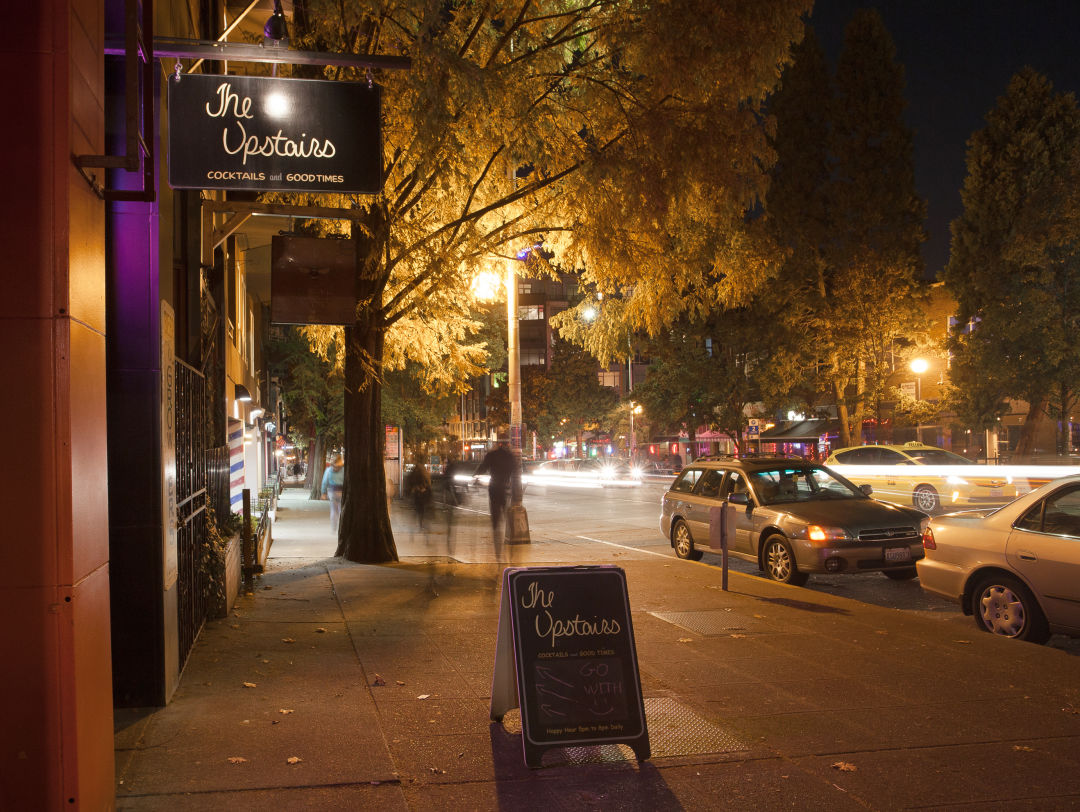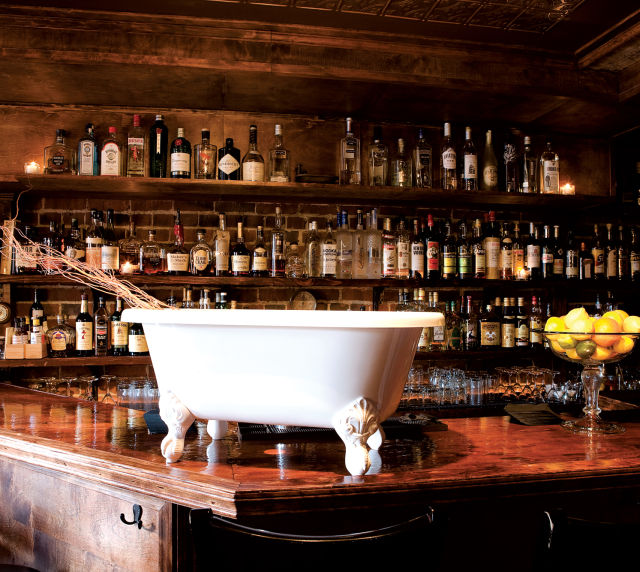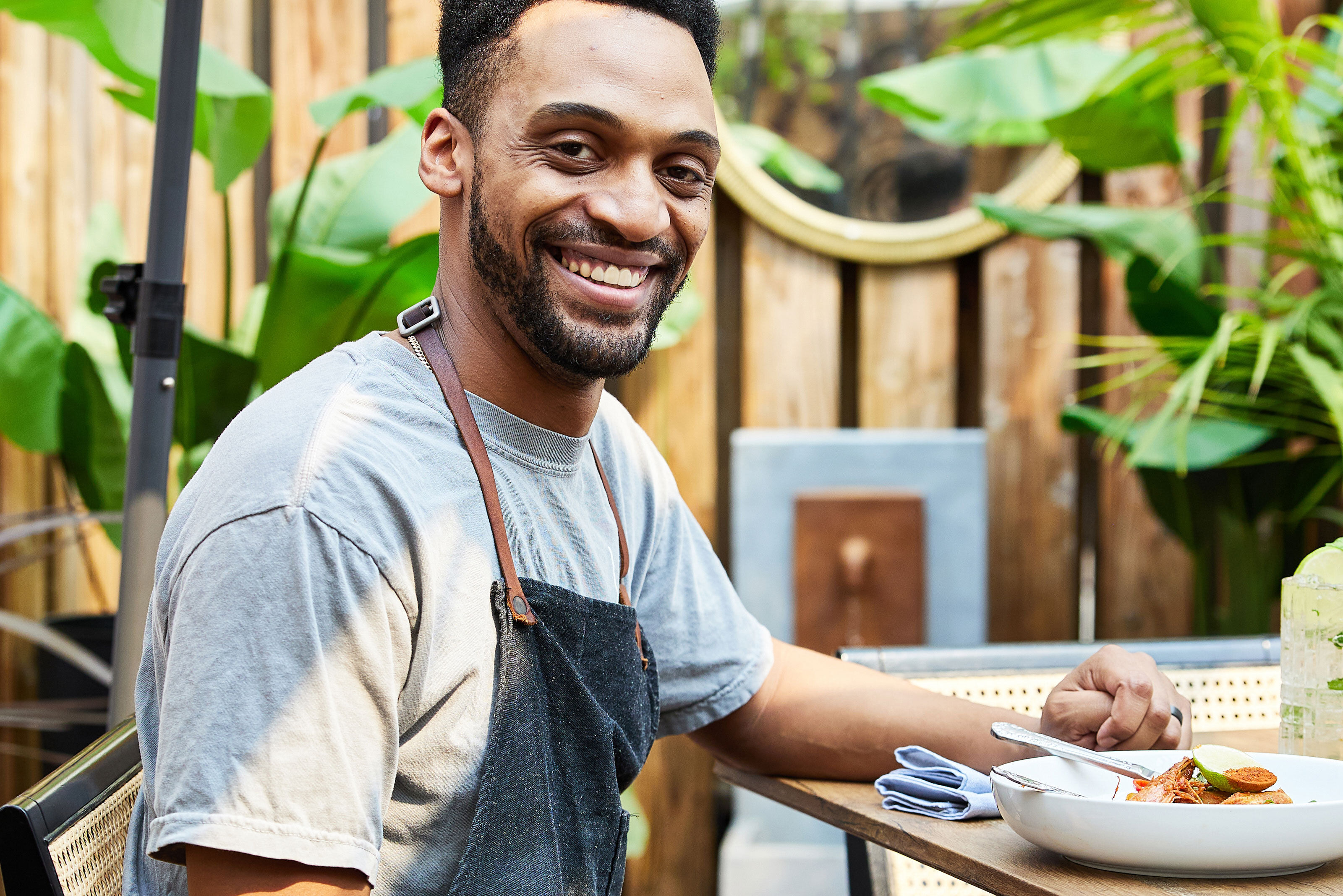Neighborhood in Flux: How Belltown Is Dealing with Its Growing Pains

Image: James Boyle
A skater wends and skids through clustered crowds—sidewalk smokers, couples on date night—as you slip into Coney Island–themed bar Shorty’s to escape the chaos only to be thrown into a different kind of bedlam entirely. Or, just a few steps away, you succumb to the lure of the bright facade at Neon Boots. (Ditto a selfie in the glowing fuchsia bathroom.) Around the corner, owners Amanda and Cory Chigbrow sling Spanish tapas at Pintxo, while the whiskey cocktails on tap flow at its sister bar, Commonwealth, a cozy, Southern-inspired lounge.
These are the manifold charms of Belltown, a playground for peripatetic weekend warriors and committed school nighters that has pumped so much blood—or was it alcohol?—into Seattle nightlife for the past two decades. But getting drunk in Belltown is an even older tradition than that. Since the 1900s transient workers from lumber camps and fishing boats would settle in for a pint. Later the neighborhood was home to 5,000 dancers waltzing around the biggest ballroom in the Northwest. In the 1950s locals called it “hobohemia,” and by the ’70s artists and musicians spurred a boomlet of cafes and clubs. Today it’s still home to myriad misfits.
There are reasons to fear the fate of one of the city’s densest bar and restaurant scenes, though. If you continue your tour along Second Avenue, planning to drop in on the velvet chaise–filled Upstairs, you may find yourself in a dentist’s office instead. For all the couple’s efforts, the bar that feels like a home because the Chigbrows once lived there (plus another downstairs, Bar Abajo) will close in December. These days, the denizens of Belltown—from tweeded cigar chompers to tech bros learning about chinook from fellow bar patrons—must fight to keep the carnival alive.

The Upstairs bar on Second Avenue will shutter in December to make way for a dentist’s office.
Image: Alison Klein
In September 2015, with nearly no warning, another Belltown fixture was in jeopardy. The 128-year-old Wayne Apartments and stretch of abutting businesses—Rocco’s pizzeria, the retro Lava Lounge nightclub, the Funky Studios residence, and Shorty’s—were bound to become a 124-unit condo tower if the Landmark Preservation Board didn’t act.
Belltown loyalists crammed into the board’s decisive meeting in October, outnumbering condo supporters, like the property owner’s attorney. The building had no integrity, the lawyer argued; too much had been altered. Beneath the unflattering glare of fluorescent lights, the community also made its case, each person leaning over the mic to deliver a 60-second plea. All but two of 26 public comments favored landmark designation, and the reasons ranged from rock legend origin stories to tenacity; the old rowhouse had survived the Denny Regrade project in the early twentieth century.
When the board finally granted the Wayne Apartments landmark status that evening, the room roared. The celebration spilled into the streets when a parade commenced on Second. “It was a ruckus,” recalls Jeff Rogers, co-owner of art-hall-slash-arcade Jupiter Bar, “full of people with big hearts.”
The old building was weathered, but it was beloved, and a symbol of the block it occupies, a refuge for Seattle’s fringe, blue-collar workers, artists, and probably a few outsiders. They’re the ones now battling for Belltown’s soul as gentrification buffets the neighborhood.
When the Lava Lounge went up for sale in 2012, Marcus Johnson and Jessica Gifford jumped at the chance to buy it, strange ephemera and all: mounted shark jaws, a dusty taxidermic crow. The entrepreneurial couple now runs four joints in the neighborhood, including the Bathtub Gin and Company speakeasy and newcomer Mr. Darcy. But Johnson says they wanted the paradise–gone–punk tiki dive “so we could keep it Lava Lounge.” Call it resistance by way of booze and nostalgia.

Inside Bathtub Gin & Co.
Image: Lindsay Borden
You could be sloshed on rosé slushies and still see Belltown’s in heavy development mode. Between 2013 and 2015, it was the fourth-fastest-growing neighborhood in Seattle, according to the city’s Urban Center/Village Residential Growth report; there are currently 11 sleek, mixed-use high-rises slated for the area.
Since 2015, Friends of Historic Belltown, a spunky grassroots nonprofit dedicated to the neighborhood’s everlasting spirit, has helped protect—in addition to the Wayne complex—Franklin and Sheridan apartments, Griffin Business School, and Mama’s Mexican Kitchen. “I don’t say we saved them because the buildings are historic; the law saved them,” Steve Hall, a Friends of Historic Belltown member, says. They’re victories nonetheless.
But it’s not all about old buildings. Evan Clifthorne, a former council member aide, founded Project Belltown a year ago to advocate for everyone from residents to property owners. Among the organization’s many ambitions: Secure more housing for the working class and replace the soon-to-be-demolished viaduct with a park. “Belltown is unique,” Clifthorne says. “It’s not defined by its proximity to Pike Place or Seattle Center.” Perhaps, then, it’s defined by the people who live, work, and fight for the neighborhood they love.
“We want to be the people that pour beers for the guys on the front line,” Johnson says. There’s probably no better way to thank them—or keep Belltown sated—than with drink.




